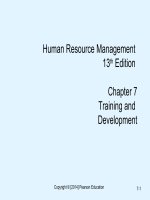Management by chuch williams chapter 07
Bạn đang xem bản rút gọn của tài liệu. Xem và tải ngay bản đầy đủ của tài liệu tại đây (540.08 KB, 32 trang )
Chapter 7
Innovation and Change
MGMT
Chuck Williams
Designed & Prepared by
B-books, Ltd.
1
Copyright ©2008 by Cengage Learning. All rights reserved
Organizational Innovation
After reading these sections,
you should be able to:
1. explain why innovation matters to companies.
2. discuss the different methods that managers
can use to effectively manage innovation in
their organizations.
2
Copyright ©2008 by Cengage Learning. All rights reserved
Why Innovation Matters
Technology
Cycles
Innovation
Streams
1
3
Copyright ©2008 by Cengage Learning. All rights reserved
Why Innovation Matters
1900-1910
• airplane, plastic, air
conditioner
1911-1920
• mammogram, zipper, sonar
1921-1930
• talking movies, penicillin, jet
engine
1931-1940
• radar, helicopter, computer
1941-1950
• atomic bomb, bikini, transistor
1951-1960
• oral contraceptive, Tylenol
1961-1970
• video recorder, handheld
calculator, computer mouse
1971-1980
• compact disc, gene splicing,
laser printer
1981-1990
• MS-DOS, space shuttle,
CD-ROM
1991-2000
• taxol, Pentium processor, Java
2001-Today
• first cloning of human embryo
1
4
Copyright ©2008 by Cengage Learning. All rights reserved
Technology Cycles
Technology Cycle
A cycle that begins with the birth” of a
new technology and ends when that
technology reaches its limits and is
replaced by a newer, better technology.
1.1
5
Copyright ©2008 by Cengage Learning. All rights reserved
S-Curves and Technological
Innovation
Performance
Discontinuity
C
New
Technology
B
A
Effort
1.1
6
Copyright ©2008 by Cengage Learning. All rights reserved
Innovation Streams
Innovation Streams
Patterns of innovation over time that can
create sustainable competitive advantage.
Technological Discontinuity
A scientific advance or unique combination of
existing technologies that creates a significant
breakthrough in performance or function.
1.2
7
Copyright ©2008 by Cengage Learning. All rights reserved
Innovation Streams:
Technology Cycles over Time
Technological
Technological
Discontinuity
Discontinuity(2)
(2)
Technological
Substitution
Era
Eraof
of
Incremental
Incremental
Change
Change(2)
(2)
Variation
Selection
Discontinuous
Discontinuous
Change(2)
Change(2)
Dominant
Dominant
Design
Design(2)
(2)
Technological
Technological
Discontinuity
Discontinuity(1)
(1)
Era
Eraof
of
Incremental
Incremental
Change
Change(1)
(1)
1.2
Variation
Selection
Dominant
Dominant
Design
Design(1)
(1)
Discontinuous
Discontinuous
Change(1)
Change(1)
8
Copyright ©2008 by Cengage Learning. All rights reserved
Innovation Streams
Technological
Technological
Discontinuities
Discontinuities
Discontinuous
Discontinuous
Change
Change
Technological
Technological
Substitution
Substitution
Design
Design
Competition
Competition
Dominant
Dominant Design
Design
1.2
9
Copyright ©2008 by Cengage Learning. All rights reserved
Managing Innovation
Managing
Sources of
innovation
Managing During
Discontinuous
Change
Managing During
Incremental
Change
2
10
Copyright ©2008 by Cengage Learning. All rights reserved
Managing Sources of Innovation
Creative work environments
Workplace cultures in which workers
perceive that new ideas are encouraged
Flow
The psychological state of effortlessness in
which you become absorbed in your work and
time seems to pass quickly
2.1
11
Copyright ©2008 by Cengage Learning. All rights reserved
Components of Creative Work Environments
Organizational
Organizational
Encouragement
Encouragement
Challenging
Challenging
Work
Work
Lack
Lackof
ofOrganiz.
Organiz.
Impediments
Impediments
Creative
Creative
Work
Work
Environments
Environments
Freedom
Freedom
Supervisory
Supervisory
Encouragement
Encouragement
Work
WorkGroup
Group
Encouragement
Encouragement
Flow
2.1
12
Copyright ©2008 by Cengage Learning. All rights reserved
Managing Innovation
During Discontinuous Change
Experiential approach to
innovation
• innovation is occurring within an
uncertain environment
• the key to innovation is to use:
– intuition
– flexible options
– hands-on experience
2.2
13
Copyright ©2008 by Cengage Learning. All rights reserved
Experiential Approach to Innovation
Design
Design Iterations
Iterations
Testing
Testing
Parts
Parts of
of
Experiential
Experiential
Approach
Approach
Milestones
Milestones
Multifunctional
Multifunctional Teams
Teams
Powerful
Powerful Leaders
Leaders
2.2
14
Copyright ©2008 by Cengage Learning. All rights reserved
Managing Innovation During
Incremental Change
• Compression approach to innovation
– assumes that innovation is a predictable process
that can be planned in steps
• Generational change
– based on incremental improvements to a
dominant design and achieving backward
compatibility with older technology
2.3
15
Copyright ©2008 by Cengage Learning. All rights reserved
Compression Approach
to Innovation
Planning
Planning
Supplier
Supplier Involvement
Involvement
Parts
Parts of
of
Compression
Compression
Approach
Approach
Shortening
Shortening Time
Time of
of
Individual
Individual Steps
Steps
Overlapping
Overlapping Steps
Steps
Multifunctional
Multifunctional Teams
Teams
2.3
16
Copyright ©2008 by Cengage Learning. All rights reserved
Managing Innovation
Experimental
Approach
Environment
Environment
Uncertain discontinuous
change:
technological substitution
and design competition
Certain incremental change
established technology
(i.e., dominant design)
Speed
Performance Improvements
New dominant design
Speed
Lower costs
Incremental improvements
in performance of dominant
design
Build something new,
different, and better
Compress time/steps needed
to bring about small
improvements
Design iterations
Testing
Milestones
Multifunctional teams
Powerful leaders
Planning
Supplier involvement
Shorten time of steps
Overlapping steps
Multifunctional teams 17
Goals
Goals
Approach
Approach
2
Steps
Steps
Compression
Approach
Copyright ©2008 by Cengage Learning. All rights reserved
Organizational Change
After reading these sections,
you should be able to:
3. discuss why not changing can lead to
organizational decline.
4. discuss the different methods that managers
can use to better manage change as it occurs.
18
Copyright ©2008 by Cengage Learning. All rights reserved
Five Stages of Organizational Decline
Blinded
Blinded
Inaction
Inaction
Faulty
Faulty
Action
Action
Crisis
Crisis
Dissolution
Dissolution
3
19
Copyright ©2008 by Cengage Learning. All rights reserved
Circuit City in
Retrenchment
Beyond the Book
• Circuit City had only one profitable quarter in 20072008. In November 2008, it had $2.3 billion in debts
with only $3.4 billion in assets.
• Former CEO Philip Schoonover moved to reduce
3,400 higher-paid management positions in March
2007. He was ousted by Circuit City’s board in
September 2008.
• Circuit City filed for Chapter 11 in November 2008
and aims to liquidate 155 U.S. stores and lay off 20%
of its workforce in an effort to regroup.
Source: K. Hudson, “Circuit City Enters New Turnaround Stage,” The Wall Street Journal, 31 May 2007, B5; M. Bustillo,
“Circuit City Seeks Haven In Bankruptcy Protection,” The Wall Street Journal, 11 November 2008..
Copyright ©2008 by Cengage Learning. All rights reserved
20
Managing Change
Change
Change Forces
Forces
Change
Change
Resistance
Resistance Forces
Forces
4
21
Copyright ©2008 by Cengage Learning. All rights reserved
Managing Change
Managing
Managing
resistance
resistance
to
tochange
change
What
Whatnot
not
to
todo
dowhen
when
leading
leadingchange
change
Different
Differentchange
change
tools
toolsand
and
techniques
techniques
4
22
Copyright ©2008 by Cengage Learning. All rights reserved
Managing Resistance to Change
Unfreezing
• Share reasons
• Empathize
• Communicate
Change
Intervention
•
•
•
•
•
•
•
Benefits
Champion
Input
Timing
Security
Training
Pace
Refreezing
• Top management
support
• Reinforce
4.1
23
Copyright ©2008 by Cengage Learning. All rights reserved
Managing Resistance to Change
Education
Education and
and Communication
Communication
Participation
Participation
Negotiation
Negotiation
Managerial
Managerial Support
Support
Coercion
Coercion
4.1
24
Copyright ©2008 by Cengage Learning. All rights reserved
Errors Made when Leading Change
Unfreezing
Unfreezing
1.
1. Not
Notestablishing
establishingaagreat
greatenough
enoughsense
sense of
ofurgency.
urgency.
2.
2. Not
Not creating
creatingaapowerful
powerful enough
enough guiding
guiding coalition.
coalition.
Change
Change
3.
3. Lacking
Lackingaavision.
vision.
4.
4. Undercommunicating
Undercommunicatingthe
the vision
visionby
byaafactor
factorof
of10.
10.
5.
5. Not
Not removing
removingobstacles
obstaclesto
to the
the new
new vision.
vision.
6.
6. Not
Not systematically
systematicallyplanning
planningfor
forand
andcreating
creatingshort-term
short-termwins.
wins.
Refreezing
Refreezing
7.
7. Declaring
Declaringvictory
victorytoo
too soon.
soon.
4.2
8.
8. Not
Not anchoring
anchoringchanges
changesin
inthe
the corporation’s
corporation’sculture.
culture.
25
Copyright ©2008 by Cengage Learning. All rights reserved









